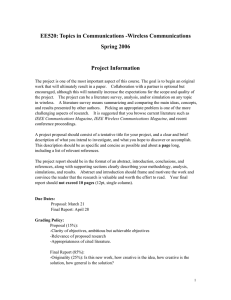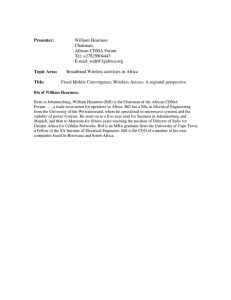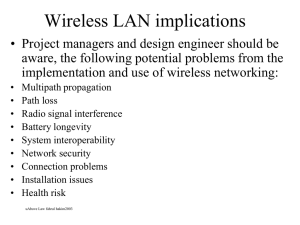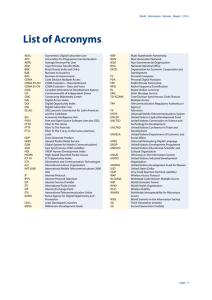Research Journal of Applied Sciences, Engineering and Technology 4(6): 660-663,... ISSN: 2040-7467 © Maxwell Scientific Organization, 2012
advertisement
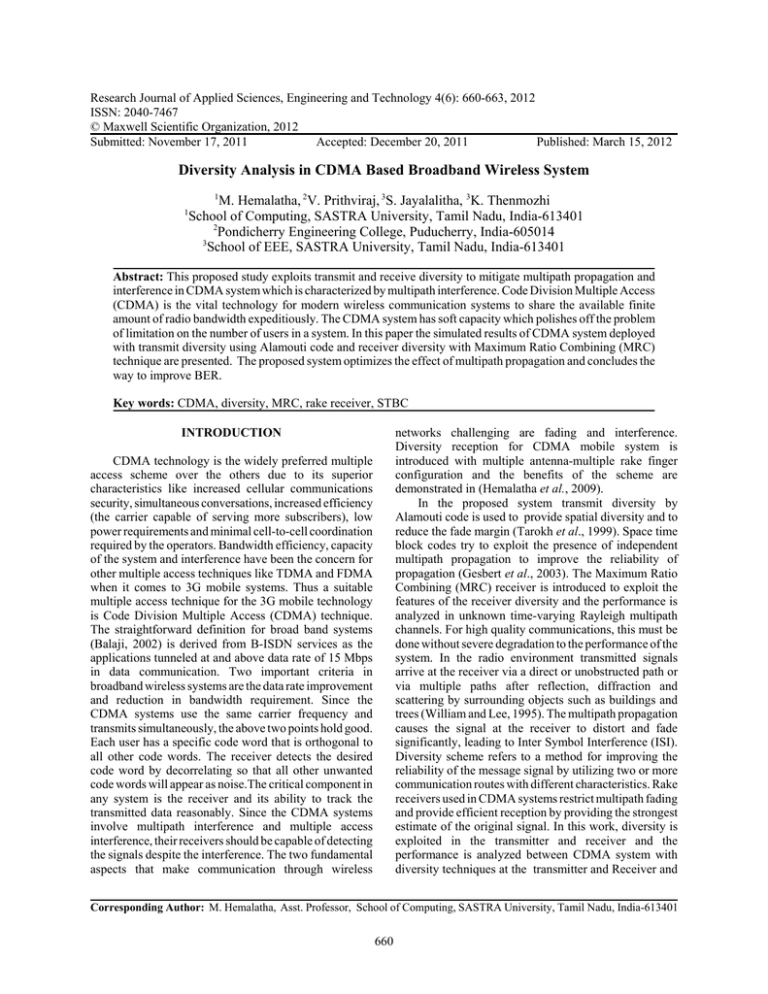
Research Journal of Applied Sciences, Engineering and Technology 4(6): 660-663, 2012 ISSN: 2040-7467 © Maxwell Scientific Organization, 2012 Submitted: November 17, 2011 Accepted: December 20, 2011 Published: March 15, 2012 Diversity Analysis in CDMA Based Broadband Wireless System 1 1 M. Hemalatha, 2V. Prithviraj, 3S. Jayalalitha, 3K. Thenmozhi School of Computing, SASTRA University, Tamil Nadu, India-613401 2 Pondicherry Engineering College, Puducherry, India-605014 3 School of EEE, SASTRA University, Tamil Nadu, India-613401 Abstract: This proposed study exploits transmit and receive diversity to mitigate multipath propagation and interference in CDMA system which is characterized by multipath interference. Code Division Multiple Access (CDMA) is the vital technology for modern wireless communication systems to share the available finite amount of radio bandwidth expeditiously. The CDMA system has soft capacity which polishes off the problem of limitation on the number of users in a system. In this paper the simulated results of CDMA system deployed with transmit diversity using Alamouti code and receiver diversity with Maximum Ratio Combining (MRC) technique are presented. The proposed system optimizes the effect of multipath propagation and concludes the way to improve BER. Key words: CDMA, diversity, MRC, rake receiver, STBC networks challenging are fading and interference. Diversity reception for CDMA mobile system is introduced with multiple antenna-multiple rake finger configuration and the benefits of the scheme are demonstrated in (Hemalatha et al., 2009). In the proposed system transmit diversity by Alamouti code is used to provide spatial diversity and to reduce the fade margin (Tarokh et al., 1999). Space time block codes try to exploit the presence of independent multipath propagation to improve the reliability of propagation (Gesbert et al., 2003). The Maximum Ratio Combining (MRC) receiver is introduced to exploit the features of the receiver diversity and the performance is analyzed in unknown time-varying Rayleigh multipath channels. For high quality communications, this must be done without severe degradation to the performance of the system. In the radio environment transmitted signals arrive at the receiver via a direct or unobstructed path or via multiple paths after reflection, diffraction and scattering by surrounding objects such as buildings and trees (William and Lee, 1995). The multipath propagation causes the signal at the receiver to distort and fade significantly, leading to Inter Symbol Interference (ISI). Diversity scheme refers to a method for improving the reliability of the message signal by utilizing two or more communication routes with different characteristics. Rake receivers used in CDMA systems restrict multipath fading and provide efficient reception by providing the strongest estimate of the original signal. In this work, diversity is exploited in the transmitter and receiver and the performance is analyzed between CDMA system with diversity techniques at the transmitter and Receiver and INTRODUCTION CDMA technology is the widely preferred multiple access scheme over the others due to its superior characteristics like increased cellular communications security, simultaneous conversations, increased efficiency (the carrier capable of serving more subscribers), low power requirements and minimal cell-to-cell coordination required by the operators. Bandwidth efficiency, capacity of the system and interference have been the concern for other multiple access techniques like TDMA and FDMA when it comes to 3G mobile systems. Thus a suitable multiple access technique for the 3G mobile technology is Code Division Multiple Access (CDMA) technique. The straightforward definition for broad band systems (Balaji, 2002) is derived from B-ISDN services as the applications tunneled at and above data rate of 15 Mbps in data communication. Two important criteria in broadband wireless systems are the data rate improvement and reduction in bandwidth requirement. Since the CDMA systems use the same carrier frequency and transmits simultaneously, the above two points hold good. Each user has a specific code word that is orthogonal to all other code words. The receiver detects the desired code word by decorrelating so that all other unwanted code words will appear as noise.The critical component in any system is the receiver and its ability to track the transmitted data reasonably. Since the CDMA systems involve multipath interference and multiple access interference, their receivers should be capable of detecting the signals despite the interference. The two fundamental aspects that make communication through wireless Corresponding Author: M. Hemalatha, Asst. Professor, School of Computing, SASTRA University, Tamil Nadu, India-613401 660 Res. J. Appl. Sci. Eng. Technol., 4(6): 660-663, 2012 Fig. 1: CDMA transmitter with diversity transmission the Single Input Single Output system (SISO). A comparison of the performance is done based on the Bit Error Rate (BER) and the SNR values. Ro = h0 S0 – h1 S1* for symbol period 0 and: R1 = h0 S1 – h1 S0* SYSTEM ARCHITECTURE (2) for symbol period 1, where h0 and h1 are the channel coefficients either known or estimated by the receiver.The receiver can then extract the transmitted symbols via the following decoding rule: The data input or the message signal is first modulated using digital Binary Phase Shift Keying (BPSK). Using the scalar dot product rule, the modulated signal is then modulated with a larger bandwidth signal which is the pseudo random sequence. To combat noise, interleaving of the signals necessary in CDMA systems. Thus, even if one block is corrupted by noise, data can be retrieved from the other blocks. This technique also introduces temporal diversity for the codes that are entered. Figure 1 Shows the transmitter used for the simulation, the Space Time Block Coder (STBC) (Alamouti, 1998; Thenmozhi et al., 2011) is introduced to exploit the transmit diversity and is shown in un-shaded block to demonstrate the difference with the conventional model. S0’ = h0* R0 + h1 R0* (3) S1’ = - h1 R0* + h0* R1 (4) where, S0’ and S1’ are the estimated symbols and the effects of noise, interference and channel estimation error are ignored. The classical space time coding for narrow band flat fading channels can be extended to broadband time-variant and frequency selective channels as space frequency coding (Andreas et al., 2005). Spatial Multiplexing (Foschini, 1996), in which multiple streams are transmitted over multiple antennas is made use of, to give the advantage of higher peak rates and increased throughput. With multiple antennas at the receiver (Foschini et al., 1999), the different streams can be separated to achieve higher throughput compared to the single antenna systems. Transmit Diversity Scheme: The transmit diversity scheme was originally formulated in a coding framework and later, the development in Trellis based Space-Time codes helped achieve both coding and full diversity gain. Alamouti invented a simple Space-Time block codes (Thenmozhi et al., 2011) over two symbols that achieve full diversity gain (Alamouti, 1998). Unlike the Space Time Trellis coding (Paulraj et al., 2003), which codes sequence of symbols according to a specified Trellis signal constellation, space time block coding codes the disjoint blocks of symbols according to a predefined coding rule. The encoder codes pairs of symbols (Tarokh et al., 1998) across two antennas according to the coding rule given in Table 1. At the receiver, the following signals are received after dispreading, which involves reconstituting the wide bandwidth signal to a narrower bandwidth. Then: Table : 1 Enocoder codes according rule Antenna 0 Symbol period 0 S0 Symbol period 1 S1 (1) Maximal ratio combining: The signals from all the branches are weighted according to their individual signal voltage to noise power ratios and then summed. These individual signals must be co-phased prior to the summing process to increase the signal to noise ratio and this requires an individual receiver and phasing circuit for each antenna element. Maximal ratio combining produces an output with an acceptable SNR even when none of the individual signals are themselves acceptable. The goal of MRC is to weigh individual diversity branches in a way that maximizes the output signal to noise ratio. This technique gives the best statistical reduction of fading of any known linear diversity combiner and thus is the best diversity combining technique (Gregory, 2003) in terms of link performance. Modern DSP techniques and digital Antenna 1 - S1* S0* 661 Res. J. Appl. Sci. Eng. Technol., 4(6): 660-663, 2012 No diversity (1 Tx, 1Rx) Alamouti (2 Tx, 1 Rx) Maximal-ratio combining - rake (1Tx, 2Rx) 0 10 -1 10 -2 BER 10 -3 10 -4 10 0 2 4 6 8 10 12 14 Eb/No (dB) 16 18 20 Fig. 5: Comparison of CDMA system with and without diversity schemes at the transmitter and receiver Fig. 2: Schematic diagram of MRC receiver relative strength of the signal. Figure 3 shows the diagram of typical rake receiver. The spreading codes with a small autocorrelation value for any non zero time offset is chosen to avoid the interference between the adjacent branches. To evaluate the system performance it is assumed that the time offset codes are truly orthogonal. Directsequence code-division multiple-access mobile communication systems, such as wideband CDMA are limited in performance by interference. Linear equalization techniques such as rake receivers and transversal chip equalizers can provide significant gains in performance by suppressing interference. RESULTS AND DISCUSSION Fig. 3: Typical rake receiver An adaptive rake receiver (Fulghum et al., 2009) employed with signal processing algorithms for finger placement and weight computation can improve the gain significantly resulting in higher-rate coverage. It is clearly seen from the Fig. 4 that the multipath fading has been substantially reduced by diversity transmission and reception, facilitating the CDMA technology to prevail successfully over the other systems. Though diversity reception reduces the multipath fading, there is a rise in the co-channel and adjacent channel interference with the number of users. Taking the demand of the present situation into consideration, it would be wise to choose multiple fingered Rake receivers with multiple antennas. From the graph in Fig. 5, it is observed that the BER for the CDMA system with one transmitter and receiver is only 10G3 for the maximum Eb/No, but it is about 10G5 for the Maximum Ratio Combiner and this demonstrates the superiority of diversity reception over single receiver system. The transmitter diversity using Alamouti coding also provides improvement in BER when compare with the SISO system, and the value observed is around 10G5 when Eb/No is 20dB. No diversity (1 Tx, 1Rx) Maximal-ratio combining - rake (1Tx, 2Rx) 0 10 -1 10 -2 BER 10 -3 10 -4 10 0 2 4 6 8 10 12 14 Eb/No (dB) 16 18 20 Fig. 4: BER performance analysis for CDMA receiver diversity receivers are now making use of this optimal form of diversity. Figure 2 Shows the schematic diagram of an MRC receiver. Rake receivers: Each of the elements in the bank of the rake receivers correlates to particular multipath component of the desired signal. The signal estimate is found by summing up weighted correlator outputs. The weight is assigned to each finger with respect to the 662 Res. J. Appl. Sci. Eng. Technol., 4(6): 660-663, 2012 Foschini, G.J., 1996. Layered space time architecture for wireless communications in a fading environment when using multielement antennas. Bell Labs Tech. J., 42-59. Foschini, G.J. G.D. Golden, P. Woliansky and R.A. Valenzuela, 1999. Simplified processing for wireless communication at high spectral efficiency. IEEE. J. Select. Areas Commun., 17: 1841-1842. Fulghum, T., D. Cairns, C. Cozzo, Y.P. Wang, G. Bottomley, 2009. Wireless communications. IEEE Trans. Wirele. Commun., 8: 3464-3474. Gesbert, D.M. Shafi, S. Da-shan, P. Smith and A. Naguib, 2003. From Theory to practice: An overview of MIMO space-Time coded wireless Systems. IEEE J. Selected Areas Commun., 22: 1716-1719. Gregory Daid Durgin, 2003. Space Time Wireless Channels. Prentice Hall Professional. Hemalatha, M. K. Thenmozhi, V. Prithivraj, Vignesh and D. Bharadwaj, 2009. Diversity reception in CDMA based broadband mobile systems. Proceeding of International Conference Wireless VITAE, 660-664. Paulraj, A., R. Nabar and D. Gore, Introduction to Space Time Wireless Communications, Cambridge University Press, Cambridge, UK, 2003. Tarokh, V., H. Jafarkhani and A.R. Calderbank, 1999. Space time block codes for orthogonal designs. IEEE Trans. Info. Theor., 45: 1456-1467. Tarokh, V., N. Seshadri and A.R. Calderbank, 1998. Space-time codes for high data rate wireless communication: Performance criterion and code construction. IEEE Trans. Info. Theor., 44: 744-765. Thenmozhi, K., K.K. Vamsi, V. Praneeth and A. Rengarajan, 2011. Space time Frequency Coded (STF) OFDM for Broadband wireless communication systems. J. Theor. Appl. Infor. Technol., 31: 53-59. William C.Y.L. 1995. Mobile Communication Design Fundamentals. 2nd Edn., SAMS publications. CONCLUSION AND FUTURE WORK The BER performance graphs clearly indicate that multiple Rake finger receiver structure with multiple antennas provides increased SNR making it suitable for efficient communication. Thus, the diversity CDMA system with multiple antennas at the transmitter and receiver results in the improvement in SNR and reduction in the multipath fading and interference. The Space Time Coded Transmitter and MRC combiner proves effective over the Single Input Single Output (SISO) antenna system. The CDMA network is expected to replace the existing communication technology for broadband wireless systems due to its higher reliability in comparison with other communication media. This work can be further extended as simultaneous transmit and receive diversity in a CDMA system and to the 4G frame work with spacefrequency coded transmitters in a frequency selective channel modeling. However, selfjamming, near-far effect and Inter Symbol Interference (ISI) remain as the challenges that have to be overcome. ACKNOWLEDGMENT The authors wish to thank Mr.Amirtharajan Rengarajan, Assistant Professor, SASTRA University for the time and support. REFERENCES Alamouti.S.M, 1998. A simple transmit diversity technique for wireless communications. IEEE J. Selected Areas Commun., 16: 1451-1458. Andreas A.Hutter, Salim Mekrazi, Beza N.Getu, 2005. Almouti based Space-Frequency Coding for OFDM. Wireless Personal Comm., 173-185. Balaji, K., 2002. Broad Band communications. Tata McGrawHill Publications. 663
